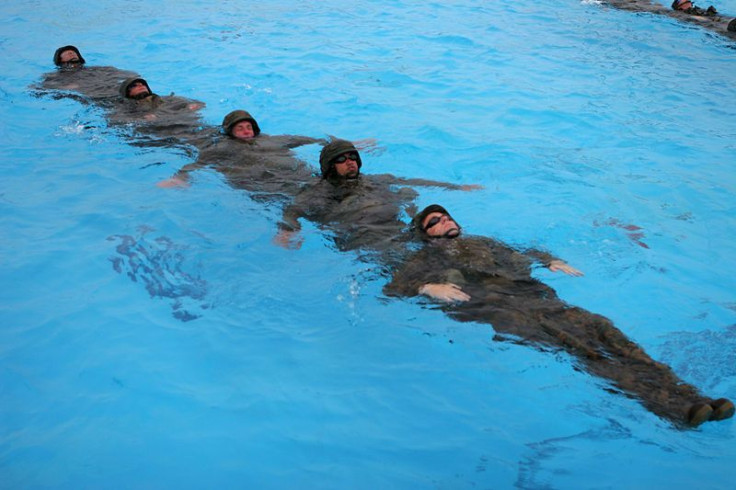How Water Aerobics Help You Stay Fit And Live Longer

It's time to make a big splash this summer — for your health. The United States Census Bureau reports that during 2009, there were 301 million swimming visits each year by Americans who were over the age of six. Swimming — ranked as the fourth most popular sports-based activity in the nation — can reduce the incidence of chronic illnesses with just two and a half hours a week, says the U.S. Department of Health and Human Services. Water aerobics is easy on the joints and can even increase muscle strength and endurance due to the water's built-in resistance. This form of exercise is preferred by many as opposed to a more traditional form of fitness, like hitting the gym, because the weight doesn't pull the person down the same way a regular workout would. Therefore, a person can exercise longer on water than on land without the extra effort or the joint and muscle pain that often accompanies a regular exercise routine because of its low impact.
Syd Hoffman, health and wellness educator in Phoenix, Ariz. and author of All-Day Energy: 100 Ways to Boost Your Energy...Now! told Medical Daily that water walking and water aerobics is "75 percent gentler on their joints," referring to people with inflammation and/or who are overweight. There is no delay of muscle soreness after a workout, which makes it a go-to activity for those looking for a low-impact aerobic workout. Joint range of motion and muscle function is increased during water fitness without having a negative impact on those who participate in it and have chronic diseases.
In a study published in the journal The Cochrane Library, researchers reviewed six studies involving 800 patients to compare the effectiveness and safety of aquatic-exercise methods to treat knee and hip osteoarthritis (OA). The results of the study showed that water aerobics have some short-term benefits for patients with knee and hip OA, and should be done as the first part of a longer exercise regimen for those with OA. Water-based activities are beneficial to those who suffer from inflammatory diseases due to the hydrostatic pressure, which aids aching joints. Janna Lowell, personal fitness trainer in Los Angeles, CA and author of Noodles For Dumbbells - Water Exercise, Weight Management & More said to Medical Daily that she believes the hydrostatic pressure helps alleviate painful joints as it "causes stagnant fluid build-up to disappear while keeping the heart rate 13-17 points lower than it would be on land with the same level of intensity." The impact of aquatic exercises on the heart rate can be a great form of exercise for individuals who suffer from heart complications.
Water aerobics can help improve the physical and mental health of an individual. The environment can help you relieve stress and tension as the muscles are loosened once you let your body submerge in water. The little to no impact on joints and muscles helps you strengthen the body and lose weight; a person who weighs 150 lbs. can burn 272 calories in one hour — sweat free!
Swimming
This form of water exercise can increase cardiovascular health, joint health, and upper and lower body strength. A swimming cardio workout is a great way to ease into exercising, especially if you are looking for a low-impact aerobic activity. Donna M. Lubrano, water fitness instructor in Boston, Mass. told Medical Daily that swimming is a great cross-training tool to keep in shape while healing from injuries, like orthopedic injuries in athletes. "[Swimming] helps with blood pressure and overall mental health and relaxation," she said.
Vertical Exercise - Water Aerobics
Unlike swimming, vertical exercise seeks to maximize resistance, which results in a core challenge. "Consequently, it is easier to keep those nasty midlife inches from accumulating in the area where they contribute to metabolic breakdown and all its associated diseases," said Lowell to Medical Daily. Water can even improve and maintain balance as it unloads the spine. This form of exercise can relieve the wear and tear of joints and help you stay fit.
For those wondering if you can rehab a knee, hip, or shoulder in the water and get cardiovascular and strength training, you can. Lubrano has worked with pre-habilitation and post-habilitation clients who were going for orthopedic surgery beforehand so they can have an increase in strength and decrease their recovery time. "Post-habilitation in conjunction with regular physical therapy increase the speed of post-surgery recovery," she said to Medical Daily.
Water Aerobics Isn't Just For The Sick And Elderly
Water aerobics is for everyone, especially athletes who are training for a marathon or fear getting injured while training. For marathon runners, Lubrano recommends to include some water running sessions in your workout. Water-based activities can increase a person's flexibility and help prevent injuries.
Read More:
Swimming Benefits: 8 Reasons Why The Sport Is Good For You



























